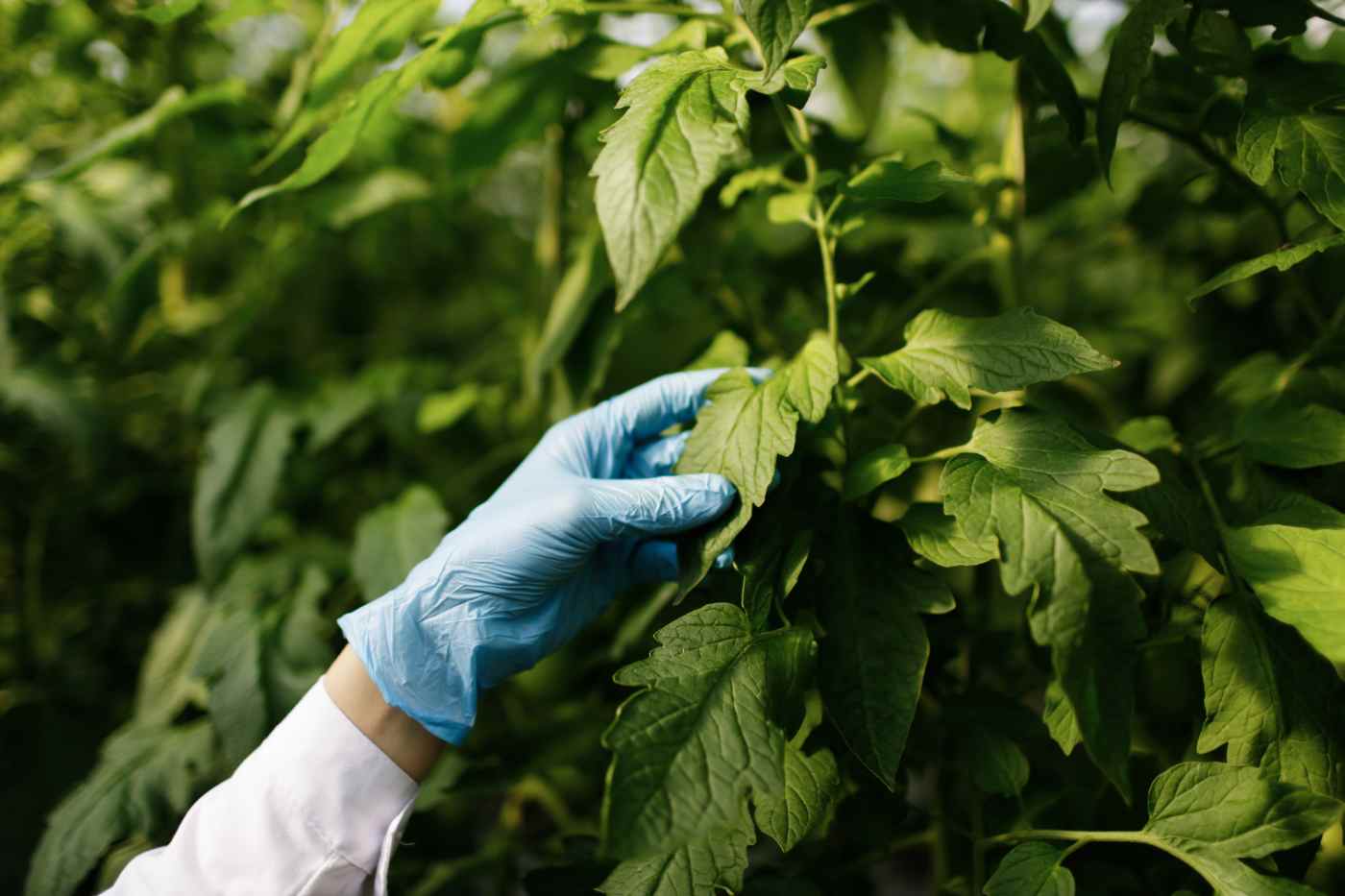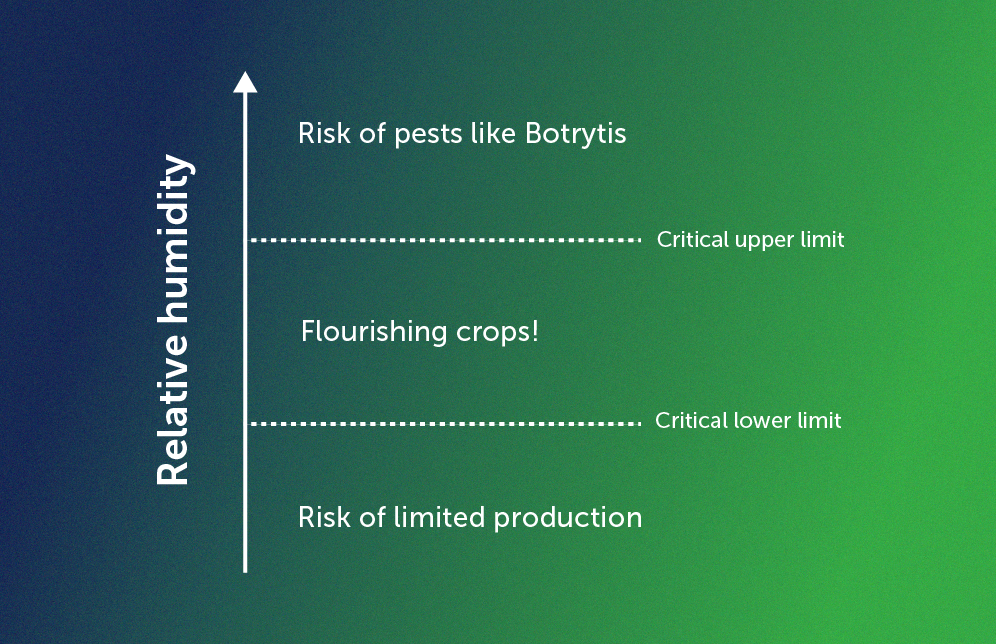
Why do tomato plants sometimes suffer from blossom end rot, even when you supply enough calcium? The answer often lies in humidity. At FOTONIQ, we focus on optimizing greenhouse climates to transform greenhouses into even more successful growing environments than that they are now.
How to describe humidity?
Humidity is the actual amount of water per unit of air, also called the vapor pressure. The quantity of water the air can contain before it is saturated is called the maximum humidity and depends on the air temperature: The higher the air temperature, the more water it can contain.
Relative Humidity (RH) is used to compare humidities at different temperatures. It is the ratio of the actual amount of water in the air to the maximum amount of water the air can hold at that temperature.
Lastly, the difference between the maximum humidity and the actual amount of water in the air is called theVapour Pressure Deficit (VPD).
Now that we have explained humidity, relative humidity and vapour pressure deficit, we will tell why it is advisable to monitor the amount of water vapour in the air of your greenhouse. Managing humidity is important as the amount of water in the air affects many plant processes:
Photosynthesis
Plants need to transpire to create the water flow that is needed for photosynthesis. A high VPD means there is a large difference between the maximum and the actual amount of water in the air. Which represents dry air. As a result, water will be pulled from the leaves into the air, causing more transpiration than needed for photosynthesis. When the VPD is too high, photosynthesis will diminish as stomata (little pores in the leaves that take in CO2) will close to retain water. A low VPD, on the other hand, means the air is humid. Consequently, less water will be drawn from the leaves and photosynthesis may be limited.
In conclusion, both too low and too high humidity levels impede photosynthesis and thus production.
Uptake of nutrients
Next to being essential for photosynthesis, the water flow in plants serves another purpose. While absorbing water, plants simultaneously pull in essential nutrients needed for their growth. High humidity levels slow the water flow, as leaves that transpire less extract fewer water and nutrients from the soil. The uptake of calcium, for example, is reduced at high humidity, which causes calcium shortages in tomato. A lack of calcium results in smaller leaves, reduced photosynthesis and blossom end rot in fruits. Similarly, the uptake of boron is reduced at high humidity levels. Boron is essential for sugar transport, cell wall stability and flowering of tomato plants. Boron shortages lead to the death of growth tips, malformed leaves and eventually lower yields.
Thus, in order to make efficient use of your fertilizer, it is important to keep an eye on humidity.
Fruit quality
A lower humidity and thus a higher VPD is not only beneficial for the uptake of nutrients, but it also improves the quality of tomatoes as well. A VPD of 0,97 kPa results in fewer blossom-end rots and misshaped fruits; higher sugar and acid concentrations, compared to a VPD of 0,40 kPa. A mild water stress results in the accumulation of sugars, animo acids and ions inside plant cells which is useful for plant growth.
Disease prevention
The most common and harmful pathogen in the cultivation of tomatoes in greenhouses is Botrytis. This fungus causes brown spots on leaves, stems and fruits. Consequently, the affected plant parts wither and die, leading to enormous yield losses. Sudden changes in the relative humidity of the air benefit the distribution of botrytis. Relative humidity levels above 95% favour botrytis germination. By keeping humidity constant and below these critical levels, botrytis can be prevented.
Prolonged periods of high humidity will result in more susceptible plants. As the air contains enough water, leaves will form more stomata (the little leaf pores that are essential for photosynthesis). Fungi and bacteria may enter plants via these stomata and pose a threat to plant health.
In summary, stable humidity levels in your greenhouse are important to optimize photosynthesis, to make good use of nutrients and to prevent diseases. Whether the humidity levels are in control depends on air temperature. After application of PAR+, our diffuse spray coating, the temperature and humidity progression will be more stable.

Sources
Dieleman, J. A. (2008). Effecten van luchtvochtigheid op groei en ontwikkeling van tomaat.
Brandsma-Razzon, D. (2024). Verdamping: Inventarisatie en kennisinteractie: Deelverslag 2 van het project“Kennisontwikkeling over verdamping: van fundamenteel naar toegepast.”
Heuvelink, E., & Körner, O. (2007). Temperature and light effects on tomato productivity in glasshouses: An analysis of seasonal variations. Acta Horticulturae, 761, 59–66. https://doi.org/10.17660/ActaHortic.2007.761.9
ivčák, M., Brestič, M., & Sytar, O. (2016). Osmotic adjustment and plant adaptation to drought stress. In N. Tuteja, S. S. Gill, A. F. Tiburcio, & R. Tuteja (Eds.), Drought stress tolerance in plants, Vol. 1: Physiology and biochemistry (pp. 105–143). Springer. https://doi.org/10.1007/978-3-319-28899-4_5
